北师大版高一英语必修二教案设计:Unit 6 Design 3 Chinese Paper Art
北师大版高中英语必修2 Unit 6《Design》(Lesson 1)教案
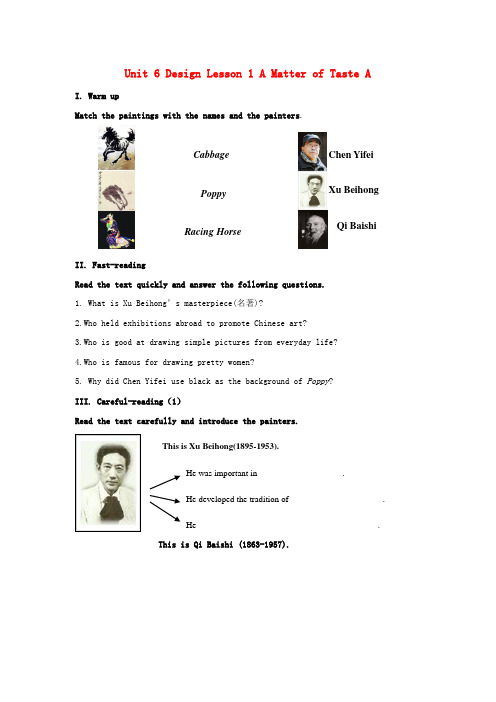
Unit 6 Design Lesson 1 A Matter of Taste AI. Warm upMatch the paintings with the names and the painters .II. Fast-readingRead the text quickly and answer the following questions.1. W hat is Xu Beihong’s masterpiece(名著)?2.Who held exhibitions abroad to promote Chinese art?3.Who is good at drawing simple pictures from everyday life?4.Who is famous for drawing pretty women?5. Why did Chen Yifei use black as the background of Poppy ?III. Careful-reading (1)Read the text carefully and introduce the painters.This is Qi Baishi (1863-1957).Racing HorseCabbagePoppyChen YifeiXu Beihong Qi BaishiHe was important in ___________________.He developed the tradition of _____________________.He _________________________________________. This is Xu Beihong(1895-1953).IV. Careful-reading(2) Read the text carefully and fill in the blanksHe was one of ___________________. During his early youth , he worked with _______. Between 1902 and 1909, he travelled across _________ and painted many picutres of _____. Later , his interest changed to ____________________. He _________________________________________. He ____________________________________________.V. Learn to describe the paintings! (1) (2) (3)2. This painting was painted by…who …Across this painting, we can see… I think that…/In my opinion,…/I feel that…1. This p ainting was painted by…who …Across this painting, we can see… The front horse is …The painter drew in black ink to show …I think that…/In my opinion,…/ I feel that… 3.This painting was painted by…In the painting, a beautiful young w She is… She is dressed in …A cat… I think that…/In my opinion,…/ I feel that…。
Chinese Paper Art 说课稿6
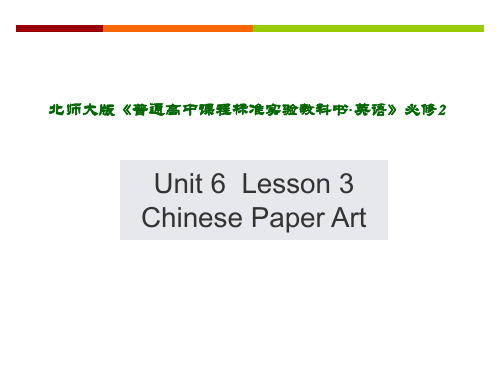
五、教学过程
Pre-reading
1. 利用图片,激活已知,引出话题,激发学生兴趣。 2. 引导学生对话题进行提问,带着阅读期待去读文章。
While-reading
1. 一读:快速阅读,了解文章大意,寻找读前提问的 答案。
2. 二读:细读文章, 借助概念图梳理信息。 3.根据概念图表达关于paper-cutting的历史、种类及用 法等信息,内化信息。
Unit 6 Design
Warm-up Lesson 1 A Matter of Taste Lesson 2 Great Building Lesson 3 Chinese Paper Art Lesson 4 Dream Houses Communication Workshop
二、教学背景分析--教材分析
北师大版《普通高中课程标准实验教科书·英语》必修2
Unit 6 Lesson 3 Chinese Paper Art
指导思想与理论依据
说
教学背景分析
课
教学目标
内
教学重难点
容
教学过程
教学特色
一、指导思想与理论依据
1.《普通高中英语课程标准》:
“高中英语课程应根据高中学生认知特点和 学习发展需要,在进一步发展学生基本语言 能力的同时,着重提高学生用英语获取信息, 处理信息,分析和解决问题的能力”。
While-reading
Post-reading
五、教学过程
Pre-reading
Pre-reading—lead in
What do you know about these pictures?
Pre-reading
Have you ever seen them?
最新北师大高一必修2Unit 6精品教案《Unit 6 Design》Communication Workshop
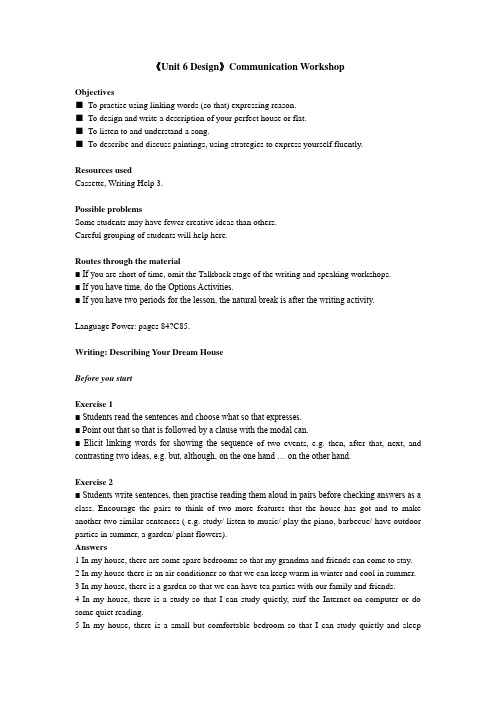
《Unit 6 Design》Communication WorkshopObjectives■To practise using linking words (so that) expressing reason.■To design and write a description of your perfect house or flat.■To listen to and understand a song.■To describe and discuss paintings, using strategies to express yourself fluently.Resources usedCassette, Writing Help 3.Possible problemsSome students may have fewer creative ideas than others.Careful grouping of students will help here.Routes through the material■ If y ou are short of time, omit the Talkback stage of the writing and speaking workshops.■ If you have time, do the Options Activities.■ If you have two periods for the lesson, the natural break is after the writing activity.Language Power: pages 84?C85.Writing: Describing Y our Dream HouseBefore you startExercise 1■ Students read the sentences and choose what so that expresses.■ Point out that so that is followed by a clause with the modal can.■ Elicit linking words for showing the sequence of two events, e.g. then, after that, next, and contrasting two ideas, e.g. but, although, on the one hand … on the other hand.Exercise 2■ Students write sentences, then practise reading them aloud in pairs before checking answers as a class. Encourage the pairs to think of two more features that the house has got and to make another two similar sentences ( e.g. study/ listen to music/ play the piano, barbecue/ have outdoor parties in summer, a garden/ plant flowers).Answers1 In my house, there are some spare bedrooms so that my grandma and friends can come to stay.2 In my house there is an air conditioner so that we can keep warm in winter and cool in summer.3 In my house, there is a garden so that we can have tea parties with our family and friends.4 In my house, there is a study so that I can study quietly, surf the Internet on computer or do some quiet reading.5 In my house, there is a small but comfortable bedroom so that I can study quietly and sleepcomfortably.Stage 1■Revise useful vocabulary by eliciting ideas for each of the items from the whole class. Students then work individually making notes about their perfect house or flat.Stage 2■ Read through the paragraph notes with the students and refer them to Wri ting Help 3 for advice on layout.■ Students then make plans for the four paragraphs. Go round and help where necessary.Stage 3■ Read the example dialogue with the class. Point out the polite ways of making suggestions (This is a great idea but what about/why don’t you …).■ Students then work in pairs, showing each other their plans and discussing them.■ If students wish to make changes to their plans after the discussion, they can do so.Stage 4■ Students then write their descriptions and che ck through for mistakes.■ Refer them again to Writing Help 3.Talkback■ In groups, students read the descriptions. If necessary, they can help correct any remaining mistakes by peer correction.■ Each group then chooses the house with the best desig n.■ The groups can report back to the class showing and describing their chosen house.Listening■ Read through the words with the class.■ Students then listen to the song to hear which words are mentioned.Answersfire flowers vase two cats windows■ Students listen to the song again and discuss what is the most important thing about the house and why the singer is so happy in the house. If there are different opinions, ask students to give reasons for their opinions.Answersb)He is happy because she is with him in the house.■ Students look at the words for two minutes, then close their books. Working as a class, students write on the board as many words as they can from the song.。
最新北师大高一必修2Unit 6精品教案《Unit 6 Design》Culture Corner
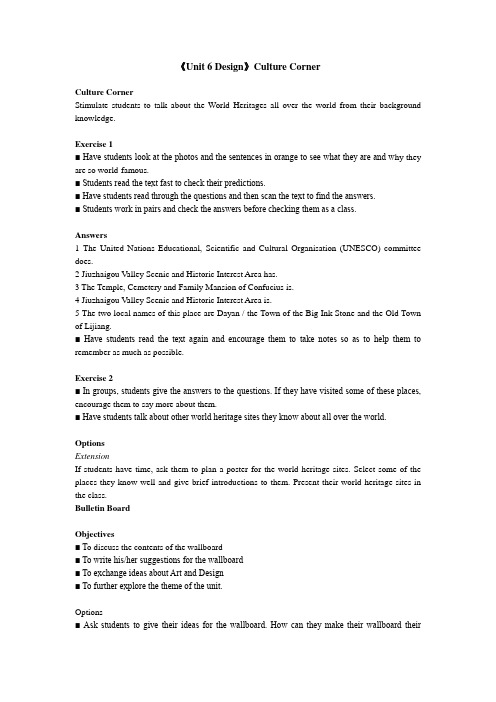
《Unit 6 Design》Culture CornerCulture CornerStimulate students to talk about the World Heritages all over the world from their background knowledge.Exercise 1■ Have students look at the photos and the sentences in orange to see what they are and w hy they are so world-famous.■ Students read the text fast to check their predictions.■ Have students read through the questions and then scan the text to find the answers.■ Students work in pairs and check the answers before checking them as a class.Answers1 The United Nations Educational, Scientific and Cultural Organisation (UNESCO) committee does.2 Jiuzhaigou Valley Scenic and Historic Interest Area has.3 The Temple, Cemetery and Family Mansion of Confucius is.4 Jiuzhaigou Valley Scenic and Historic Interest Area is.5 The two local names of this place are Dayan / the Town of the Big Ink Stone and the Old Town of Lijiang.■ Have students read the text again and encourage them to take notes so as to help them to remember as much as possible.Exercise 2■ In groups, students give the answers to the questions. If they have visited some of these places, encourage them to say more about them.■ Have students talk about other world heritage sites they know about all over the world.OptionsExtensionIf students have time, ask them to plan a poster for the world heritage sites. Select some of the places they know well and give brief introductions to them. Present their world heritage sites in the class.Bulletin BoardObjectives■ T o discuss the contents of the wallboard■ To write his/her suggestions for the wallboard■ To exchange ideas about Art and Design■ To further explore the theme of the unit.Options■ Ask students to give their ideas for the wallboard. How can they make their wallboard theirschool’s best-ever wallboard? What works of art or design would they like to put on the wallboard? What photos and pictures will they bring to the wallboard?...■ Ask the students to read the notes on the Bulletin Board individually and see what information is included in each note.■ Encourage students to write their own suggestions to make the wallboard most interesting, colourful and meaningful.■ Display their suggestions on the class bulletin board. Encourage students to read other students’ writings after class.Unit DiaryObjectives■ To encourage students to reflect on what they have learned in this unit■ To encourage students to think ab out their own learning style■ To identify effective learning methods■ To develop students’ confidence■ To encourage students to take active control of their studies■ To help teachers get a clearer insight into the students’ learning strengths and w eaknessesPart 1(1)This asks students to think of the topics of the unit and decide which lesson was their favourite.Part 2 (2-6)This part refers back to the unit objectives from the start of the unit. Students will think about what they have learned in this unit.Part 3 (7-9)This part gets students to reflect on the listening and reading texts, to identify the vocabulary that students still have difficulties with in the unit.Part 4 (10)This asks students to reflect on learning strategies and to identify and discuss ways to improve their language learning.Part 5 (11)This allows students to evaluate their progress over the course of the unit and think about how to make improvement in their English study.。
高中英语北师大版必修二 Unit 6 design课程教学设计
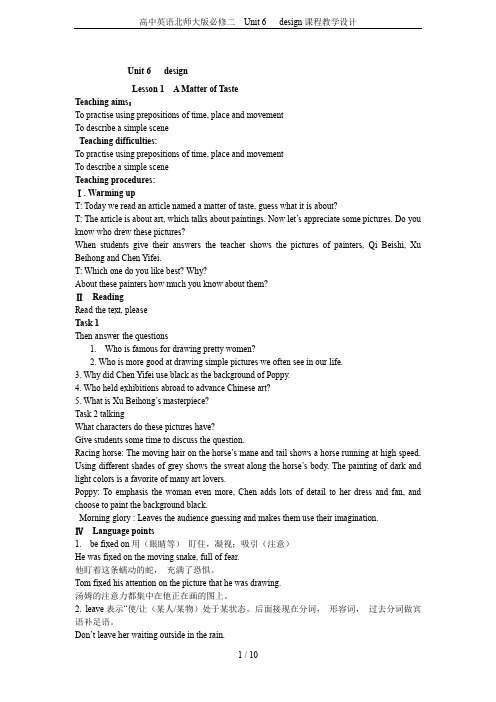
Unit 6 designLesson 1 A Matter of TasteTeaching aims:To practise using prepositions of time, place and movementTo describe a simple sceneTeaching difficulties:To practise using prepositions of time, place and movementTo describe a simple sceneTeaching procedures:Ⅰ. Warming upT: Today we read an article named a matter of taste, guess what it is about?T: The article is about art, which talks about paintings. Now let’s appreciate some pictures. Do you know who drew these pictures?When students give their answers the teacher shows the pictures of painters, Qi Beishi, Xu Beihong and Chen Yifei.T: Which one do you like best? Why?About these painters how much you know about them?ⅡReadingRead the text, pleaseTask 1Then answer the questions1.Who is famous for drawing pretty women?2. Who is more good at drawing simple pictures we often see in our life.3. Why did Chen Yifei use black as the background of Poppy.4. Who held exhibitions abroad to advance Chinese art?5. What is Xu Beihong’s m asterpiece?Task 2 talkingWhat characters do these pictures have?Give students some time to discuss the question.Racing horse: The moving hair on the horse’s mane and tail shows a horse running at high speed. Using different shades of grey shows the s weat along the horse’s body. The painting of dark and light colors is a favorite of many art lovers.Poppy: To emphasis the woman even more, Chen adds lots of detail to her dress and fan, and choose to paint the background black.Morning glory : Leaves the audience guessing and makes them use their imagination.ⅣLanguage points1.be fixed on用(眼睛等)盯住,凝视;吸引(注意)He was fixed on the moving snake, full of fear.他盯着这条蠕动的蛇,充满了恐惧。
北师大版高中英语必修2Unit6教案《Unit 6 Design》教学指导

《Unit 6 Design》教学指导Unit objectivesDraw students' attention to the unit objectives at the top of the page. As this is the last unit of the module 2, ask students which of these objectives they feel most confident about approaching and which they feel least confident about. At the end of the unit, ask students if they now feel more confident about achieving the latter.Resource usedCassette.BackgroundDavid Hockney (1937), English painter and photographer, is famous for his satirical paintings and penetrating portraits.His style is na.ve on purpose and he uses bright and flat acrylic colours. A Bigger Splash (1967) is one of his best known works.Pablo Picasso (1881?C1973), Spanish painter and sculptor, is considered by many the most genial artist of our century. He was creative and prolific. He innovated styles and techniques and was the spinning wheel for many changes in twentieth century painting.Leonardo da Vinci (1452-1519) was an Italian artist and painter. He was also fascinated by machines and designed an early helicopter. He painted the famous 'Mona Lisa'.Wassily Kandinsky (1866?C1944), was a Russian expressionist painter. He painted the first purely abstract paintings in European art. His paintings are characterised by vivid colours and analogies to music.Exercise 1■ Students look at the paintings and names of the artists. Encourage students to say as much as possible about the paintings and the artists.Exercise 2Key Wordsstyle: realistic, abstract, pop, modernsubject: scenery, people, warcolours: light/dark, bright, softshapes: round, square, clearlines: straight/wavy, hard■ Go through the Key Words with the class, asking students to point to one of the paintings which demonstrates the meaning or to translate it. Refer students to a dictionary for checking the meaning of words. Those students who are interested in art will be able to contribute more at this stage.■ In pairs, students look at each painting and match some of the Key Words to it. Have students make sentences about the paintings, e.g. 'This is a realistic painting of scenery with bright colours and clear shapes.'Exercise 3■Students listen to the cassette and identify the paintings the people are talking about. Play the cassette two or three times if necessary.Answers1 da Vinci2 Kandinsky3 Picasso4 HockneyTapescript1 I definitely think this one’s the best. The woman looks so peaceful.It looks like she’s keeping a secret and her eyes are almost watching you. Even though the painting is quite dark, it feels like it is full of light.2 Personally, I think this one is good. It’s got very strong lines and you can almost feel the music. And the colours ?C they’re great ?C they’re really bright. I like abstract paintings because you have t o use your own imagination to understand what the painter is trying to do. I think …3 This one’s my favourite. It shows war really well ?C with the dark, dark colours and the terrible pictures. The lines and shapes are square and hard. They show violence and pain. Look at the horse and the mother with her dead child. It’s a very frightening painting because …4 Well, I think this one’s the best. I really like the bright colours and the clear lines. I love the colour of the water in the swimming pool.Th e style’s strange ?C it’s realistic, but very simple at the same time.■Play the cassette again, pausing after each speaker to ask why he/she likes this painting.Exercise 4■ In pairs, students discuss the paintings saying which they like most. Assi st students, writing any words they want to know on the board.■ Have a hands-up vote on the paintings.OptionsPracticeRevise an area of vocabulary connected with art with the class, e.g. shapes (circle, square, triangle, etc.) or colours (shades of primary colours ?C pale pink, dark red, etc.)ExtensionHave a class discussion about whether students have been to any museums or art galleries, or have read art books or seen any paintings in any other form. Find out if they are interested in the topic and what can be done to make art more accessible to young people.。
2019-2020年北师大版高中英语必修2 unit 6《design》lesson 1教案3.doc

Unit 6 Design Lesson 2 Great BuildingsBackground information:Students: Senior high school students, Grade 1Teaching contents: Lesson 2 Great Buildings ( skills Focus) Unit 6, Module 2 Time: 45msTeaching Objectives:A. General goals: to develop Ss’listening skills: listening for specific informationB. More specific goals:By the end of the lesson, students are able to:1. understand a radio programme about great buildings;2. take notes while listening;3. use the keys words they learn in the lesson to describe buildings:period: in the ancient/modern time, in the early twentieth century, in the 1930s material(s): stone, marble, glass, metal, concretefeature(s): balcony, tower, roof, statuebuildings: palace, bank, castle, skyscraper4. describe great buildings;5. talk about their own building imagined;6. appreciate the beauty of great buildings;7. write a description of one of the great buildings.Teaching aids:Audio-visual method.CIA ( Computer- Instructive Assistant)Teaching Procedure:I. Pre-listening: (10 mins)1. To discuss the lesson objectives with the Ss so that they can have a general idea of what to learn in the period;2. To motivate students to listen by taking a glimpse of some of the great buildings in the world;3. To learn Key Words by taking Petronas Towers in Kuala Lumper as an example.A) When was it built? What is it built of?It’s a modern building built in (1998) the late twentieth century. It’s made of glass, steel and concrete.What do people use to make such great buildings? (show pictures: metal, glass, concrete ,wood, bamboo, stone, etc.)B) What kind of building is it?It’s a skyscraper or a commercial office tower.T: Every building has its purpose. Look at the following buildings, guess what kind of building each one is. (Show pictures)(Picture 1) This is a a very tall modern city building ( a skyscraper)(Picture 2)This a building where people can read or borrow books. ( a library) (Picture.3) This is a place where people can put their money or take it out. (A bank) (Picture 4) This is a building with thick walls ,towers,. ( a castle)(Picture 5) This is a place where King and Queen live ( a palace)(Picture6) This is a building with a lot of rooms which people pay to live in. ( a hotel)) 4. FeaturesTake a closer look at the building, which part of it attracts you most? (A sky bridge, glass wall and roof)Layout on the blackboard:It was built in…It is/was made of …It’s a /one of the ….It has…/ There is …/ It looks (like)…/ It is the…(Goal for this step: Let the students watch, listen and understand keys words about buildings.)II. While-listening (20 mins)1. Listen to the radio programme for the first time, match the buildings in the photos with the names.2. Listen to the first two sections and choose the right answersSection A : Description of the Palace of the Doges1.What kind of building does the man mention?A. palaceB. bankC. skyscraperD. castle2.In which period was the building built?A. modernB. ancientC. 1930sD. early twentieth century3.What kind of material(s) was the building made of?A. concrete, metal and glassB. stoneC. not mentionedD. marble4.What features does the building have?A. balcony and statuesB. tower and thick wallsC. metal roofD. fantastic decorations on the roofSection B : Description of the Post Office Saving Bank1. What kind of building does the man mention?A. palaceB. bankC. skyscraperD. castle2. In which period was the building built?A. modernB. ancientC. 1930sD. early twentieth century3. The most beautiful part of the building is______.A. the wallB. the roofC. the balconyD. the statue4. The fantastic decorations represent the following except_______.A. angelsB. wavesC. fishD. flowers3. Listen to section 3 and fill in the formDescription of the Eilean Donan Castle4. Read through and try to fill in the missing words in the description. Then listen to this section and check the answers.Description of the Chrysler BuildingThe Chrysler Building in _____ ______is not the skyscraper there, but it is one of the most________. This __________was made of new : metal, ________and glass. It was built in the _________ and has a beautiful metal .5. Listen to the radio programme again as a whole and take notes (exercise 3) with the key information.III Post-listening: (15 mins)1. Choose one of the buildings to describe, using the tips given (5 mins): ( provide 3 buildings for Ss to choose from, including one from the listening material)Useful language:It is/was located…/ It is one of the…/ it was built…/ It has………Name: Petronas TowersLocation: Kuala Lumper, MalaysiaDate : 1998Building Type: skyscraper / commercial office towerFeature: sky bridge2. Group work: If you were an architect, …(10 mins)What kind of building would you like to build? (Hotel? Skyscraper? …)Where would it be built? ( On the loch? in the forest? under the sea? on the moon?….) What materials would you use? ( concrete? plastic? paper? …)What would be so special about it? ( It would look like…)Share your idea about the building, even a crazy one!Optional activities and homework:Reflection:*。
高中英语北师大版必修二课件:Unit+6+Design+Period+Three+Lesson+3+Chinese+Paper+Art
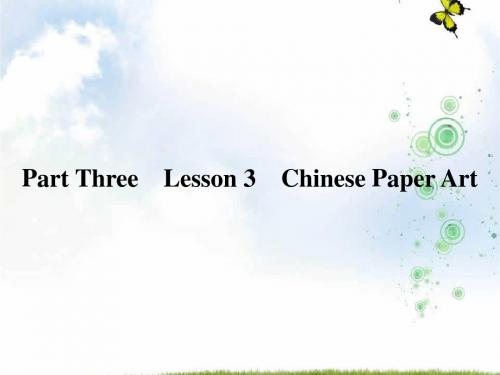
Part Three
Lesson 3
Chinese Paper Art
这次采访很有用,因为我为我的文章搜集了大量有趣的信息。 我也准备亲自尝试一下剪纸。“下周见。”在向陈先生挥手告别 时我说道。我打算再见他一面,这样他就可以帮助我制作我的第 一张剪纸了!
Ⅰ.根据课文选择最佳答案
1.From the interview,we still have no idea ________.
10.jewellery n. (总称)珠宝
Ⅱ.短语默写 1. date back (to) 2. laugh at 嘲笑 追溯(到)
3.go on to do sth 继续做某事(另外一件事) 4.put up 5. try out
张贴;搭起;举起
试用,试验
与……相关/有联系
6.be related to
.
could help me make my first paper cut!
课文译文 剪纸艺术 陈子江是一位剪纸专家, 因为我要写一篇关于中国艺术的文章 便采访了他。他自幼就学习剪纸。 陈先生告诉我说: “剪纸是一门历史悠久的中国民间艺术。 在 南北朝时期的墓中就已经发现了动物剪纸!”他补充说,到南宋 时期,剪纸就已经成为了日常生活的重要组成部分。“一位想要 娶妻的年轻农民在娶一名年轻女子前会先看看她的剪纸手艺!” 陈先生解释道,看到我脸上吃惊的表情,他笑了。
A.when people began to make paper cuts B.how many kinds of paper cuts there are C.what paper cuts are used for D.how many paper-cutting artists there are now
北师大版高中英语必修2Unit6教案《Unit 6 Design》Project
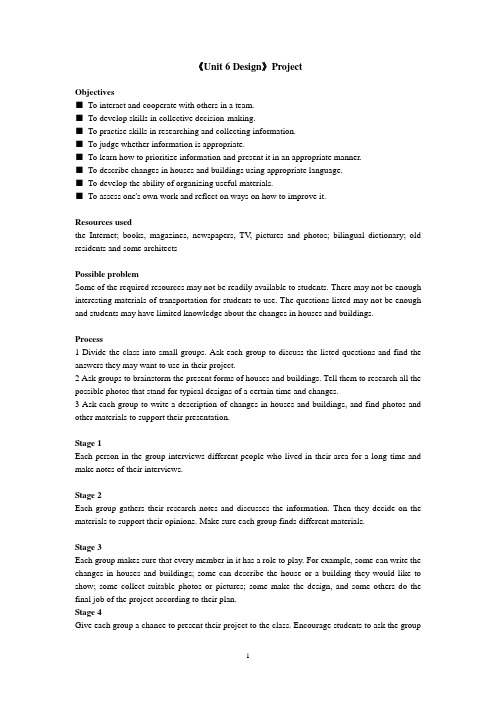
《Unit 6 Design》ProjectObjectives■To interact and cooperate with others in a team.■To develop skills in collective decision-making.■To practise skills in researching and collecting information.■To judge whether information is appropriate.■To learn how to prioritize information and present it in an appropriate manner.■To describe changes in houses and buildings using appropriate language.■To develop the ability of organizing useful materials.■To assess one's own work and reflect on ways on how to improve it.Resources usedthe Internet; books, magazines, newspapers, TV, pictures and photos; bilingual dictionary; old residents and some architectsPossible problemSome of the required resources may not be readily available to students. There may not be enough interesting materials of transportation for students to use. The questions listed may not be enough and students may have limited knowledge about the changes in houses and buildings.Process1 Divide the class into small groups. Ask each group to discuss the listed questions and find the answers they may want to use in their project.2 Ask groups to brainstorm the present forms of houses and buildings. Tell them to research all the possible photos that stand for typical designs of a certain time and changes.3 Ask each group to write a description of changes in houses and buildings, and find photos and other materials to support their presentation.Stage 1Each person in the group interviews different people who lived in their area for a long time and make notes of their interviews.Stage 2Each group gathers their research notes and discusses the information. Then they decide on the materials to support their opinions. Make sure each group finds different materials.Stage 3Each group makes sure that every member in it has a role to play. For example, some can write the changes in houses and buildings; some can describe the house or a building they would like to show; some collect suitable photos or pictures; some make the design, and some others do the final job of the project according to their plan.Stage 4Give each group a chance to present their project to the class. Encourage students to ask the groupquestions about their project.Stage 5Ask each group to do a self-assessment with the following questions.1. Was it difficult to find relevant information for this project?2. Did you find enough material for your presentation?3. Are you satisfied with your group’s presentation? Why or why not?4. How would you improve your project work in the future?5. What have you learned from doing this project?Stage 6Ask a student from each group to read out their answers to the assessment questions. Comment and encourage students to think about their answers as preparation for their next project.。
2020-2021学北师大版高中英语必修2教案:Unit6 Design Word版含解析

Unit 6 Design□wavy adj. □loch n. □balcony n. □jewellery n.□missile n. □fairytale n. □roof n. □cottage n.□marble n. □insect n. □statue n. □rent n.□phoeni x n. □mane n. □skyscraper n. □worm n.□rooster n. □artist n. □garbage n. □pipe n.□subway n. □cloth n. □lorry n. □washroom n.□angel n. □shore n. □café n. □bathtub n.□offering n. □eyesight n. □curtain n. □basement n.□landlord n. □castle n. □dynasty n. □fence n.□bat n. □concrete n. □temple n. □garage n.□apartment n.1.(2019·全国卷Ⅰ)I count twelve shades of green from where I stand.浓淡深浅;色度2.(2019·全国卷Ⅲ)...they were performing a calculation,not just memorizing the value of each combination.数值[单词拼写·运用]核心单词语境运用1.straight adj.直的adv.直,直接2.painter n.画家;油漆匠3.shade n.(色彩的)浓淡;阴影4.sweat n.汗用所给词的适当形式填空。
1.The house has many interesting features(feature).The one I like best is a largeVictorian fireplace.12.come_out 出来;出版hold_my_breath in order not to interrupthim when I go to visit him.He is a generousman and ⑧shares his pictures with us.13.be_determined_to_do_sth. 决心做某事14.be_home_to ……的家园,……的所在地15.more_than 多于;不只是;非常16.add...to... 增添,增加17.come_up 走近;被提出18.match...with 使……和……相配选用左栏短语的适当形式填空。
北师大版高中英语必修2Unit6《Design》教案2
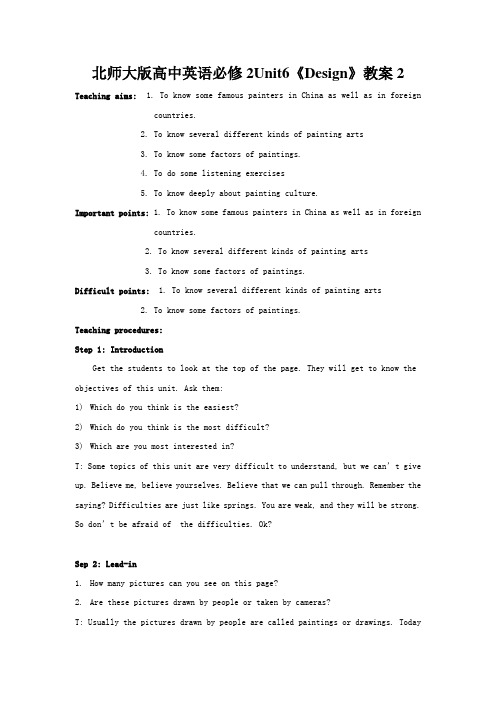
北师大版高中英语必修2Unit6《Design》教案2 Teaching aims: 1. To know some famous painters in China as well as in foreign countries.2. To know several different kinds of painting arts3. To know some factors of paintings.4. To do some listening exercises5. To know deeply about painting culture.Important points: 1. To know some famous painters in China as well as in foreign countries.2. To know several different kinds of painting arts3. To know some factors of paintings.Difficult points: 1. To know several different kinds of painting arts2. To know some factors of paintings.Teaching procedures:Step 1: IntroductionGet the students to look at the top of the page. They will get to know the objectives of this unit. Ask them:1)Which do you think is the easiest?2)Which do you think is the most difficult?3)Which are you most interested in?T: Some topics of this unit are very difficult to understand, but we can’t give up. Believe me, believe yourselves. Believe that we can pull through. Remember the saying? Difficulties are just like springs. You are weak, and they will be strong. So don’t be afraid of the difficulties. Ok?Sep 2: Lead-in1.How many pictures can you see on this page?2.Are these pictures drawn by people or taken by cameras?T: Usually the pictures drawn by people are called paintings or drawings. Todaylet’s discuss some famous paintings and some painters. There are many different kinds of paintings.Material: canvas, watercolour, brush drawing, painting in fresco.Style: realistic, abstract, pop, modern, classicalSubjects: portrait, self-portrait, landscape, drawing from natureStep 3: DescriptionLook at the paintings and describe them with the words given.Eg: A---- It’s very frightening painting. The lines and shapes are squre and hard. They show violence and pain. We can see the horse and the mother with her dead child. It is Picasso, Spanish painter and sculptor’s painting.B----- It is called Improvisation 28- Wassily Kandinsky’s painting. It is an abstract painting. It is hard to understand.C----- The painting is called A bigger Splash- David Hockney. It is a realistic painting of scenery with bright colours and clear shapes.D----- It is called Mona Lisa- Leonardo da Vinci, a Italian artist and painter.His paintings are characterized by vivid colours and analogies to music.Step 4: Do Ex 3 at P35.Listen and identify the paintings.Step 5: DiscussionIn pairs, students discuss the paintings, saying which they like most. Assist students, writing any words they want to know on the board.Step 6: Homework1.Word Corner at P79.2.Make preparations for Lesson One.。
最新北师大高一必修2Unit 6精品教案《3 Chinese Paper Art》教学指导
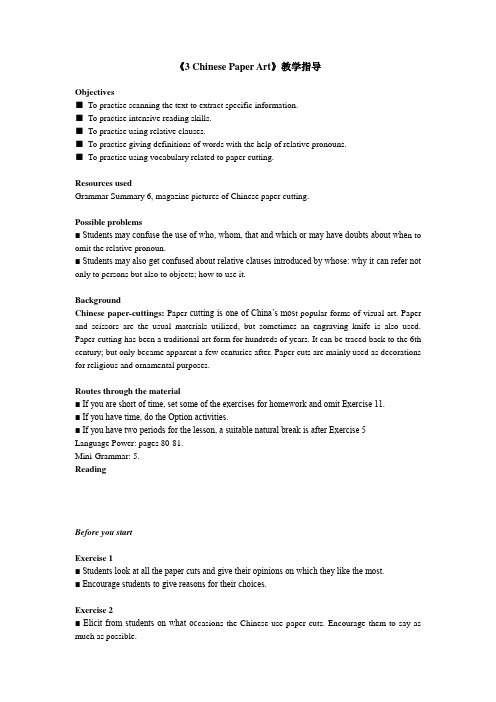
《3 Chinese Paper Art》教学指导Objectives■To practise scanning the text to extract specific information.■To practise intensive reading skills.■To practise using relative clauses.■To practise giving definitions of words with the help of relative pronouns.■To practise using vocabulary related to paper cutting.Resources usedGrammar Summary 6, magazine pictures of Chinese paper cutting.Possible problems■ Students may confuse the use of who, whom, that and which or may have doubts about whe n to omit the relative pronoun.■ Students may also get confused about relative clauses introduced by whose: why it can refer not only to persons but also to objects; how to use it.BackgroundChinese paper-cuttings: Paper-cutting is one of China’s mos t popular forms of visual art. Paper and scissors are the usual materials utilized, but sometimes an engraving knife is also used. Paper-cutting has been a traditional art form for hundreds of years. It can be traced back to the 6th century; but only became apparent a few centuries after. Paper cuts are mainly used as decorations for religious and ornamental purposes.Routes through the material■ If you are short of time, set some of the exercises for homework and omit Exercise 11.■ If you have time, do the Option activities.■ If you have two periods for the lesson, a suitable natural break is after Exercise 5Language Power: pages 80-81.Mini-Grammar: 5.ReadingBefore you startExercise 1■ Students look at all the paper cuts and give their opinions on which they like the most.■ Encourage students to give reasons for their choices.Exercise 2■ Elicit from students on what oc casions the Chinese use paper cuts. Encourage them to say as much as possible.Exercise 3Key WordsAnimals: phoenix, dragon, rooster, batColours: red, (dark) green, black, (light) blue, purple, yellow■ Check students’ knowledge of animals and colo urs. Encourage them to say more.■ Students read the example first so that they have a model to follow.■ Students work in pairs and describe each paper cut, using as many Key Words as possible. If you wish, have each pair describe two of the paper cuts.■ Students then read their descriptions to the class.Read to learnExercise 4■ Students work individually, scanning the text for information about when and why paper cuts are used.■ Students look through the questions first and guess the possibl e answers. Then read the text carefully to find the answers to the questions.■ Students ask and answer the questions in pairs.Answers1 Three. Paper cuts for decorations, for religious purposes and for design patters.2 We know that because paper cuts of animals have been found in tombs dating back to the time of the Northern and Southern Dynasty.3 The Chinese character of double happiness often appears in wedding paper cuts.4 By using paper-cutting like a pattern on clothing or on a jewellery box.5 To learn paper cutting from him.■ Encourage students to add any other information that they know about paper-cutting. Write the new facts on the board. Students discuss whether the new information can go into the existing paragraphs or whether new paragraphs are needed.Exercise 5■ In groups, students work out the meaning each paper cut has and discuss it.■ Each group reports their results to the class and gives reasons.Have a class discussion if necessary.GrammarRELATIVE CLAUSES (I)Exercise 6■ Write one sentence with a relative pronoun from the text on the blackboard. For example: Chen Zijiang is a paper-cutting expert whom I interviewed ...■ Encourage students to work in pairs and scan the text for other examples of relative pro nouns. ■ In pairs, students work out which relative pronoun can refer to people or things. ( Better leave 'whose' to learn later)。
高中英语 Unit 6 Design Lesson 3 Chinese Paper Art教案 北师大版必修2
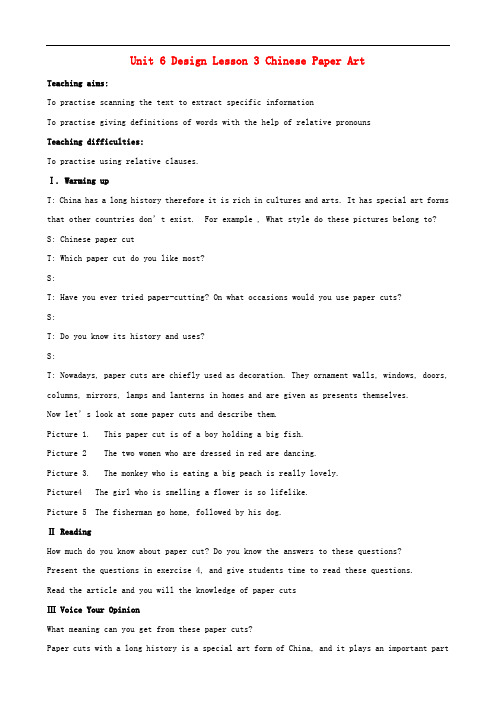
Unit 6 Design Lesson 3 Chinese Paper ArtTeaching aims:To practise scanning the text to extract specific informationTo practise giving definitions of words with the help of relative pronounsTeaching difficulties:To practise using relative clauses.Ⅰ. Warming upT: China has a long history therefore it is rich in cultures and arts. It has special art forms that other countries don’t exist. For example , What style do these pictures belong to? S: Chinese paper cutT: Which paper cut do you like most?S:T: Have you ever tried paper-cutting? On what occasions would you use paper cuts?S:T: Do you know its history and uses?S:T: Nowadays, paper cuts are chiefly used as decoration. They ornament walls, windows, doors, columns, mirrors, lamps and lanterns in homes and are given as presents themselves.Now let’s look at some paper cuts and describe them.Picture 1. This paper cut is of a boy holding a big fish.Picture 2 The two women who are dressed in red are dancing.Picture 3. The monkey who is eating a big peach is really lovely.Picture4 The girl who is smelling a flower is so lifelike.Picture 5 The fisherman go home, followed by his dog.Ⅱ ReadingHow much do you know about paper cut? Do you know the answers to these questions?Present the questions in exercise 4, and give students time to read these questions.Read the article and you will the knowledge of paper cutsⅢ Voice Your OpinionWhat meaning can you get from these paper cuts?Paper cuts with a long history is a special art form of China, and it plays an important partin people’s everyday life.Ⅳ Knowledge StructureTrue or False1.The text introduces four uses of the paper-cutting.2. Paper cut has something to do with clothing design.3. Relations often use paper cuts to do something for the dead on special days.4. The earliest paper cut dates back to the Southern Song Dynasty .5. The text refers to us that paper cuts was once a necessary skill of a youngwoman.6. Paper cuts are early found in tombs in the Northern and southern Dynasty.7. The text introduce the history and uses of Chinese paper cuts.Answers: 1.F 2.T 3.T 4.F 5.T 6.T 7.TCorrect mistakes1.Chinese paper cuts has long history.2. Paper cuts are usually put on gates and windows for good luck.3. Paper cuts are used for religious purposes are often found in temples.4. These paper cuts are prepared for dead.5. Before marrying with her , the farmer want to see her paper cuts.Answers: 1. has后加 a 2.on改为up 3. 去掉are 4. dead前面加 the 5. 去掉with ⅤLanguage points1.marry vt.marry somebody娶某人,嫁给某人He promises if he marries her , he will make her happy.他许诺如果他娶了她,会让她幸福。
北师大英语高一必修二 第六单元 lesson3 说课教案
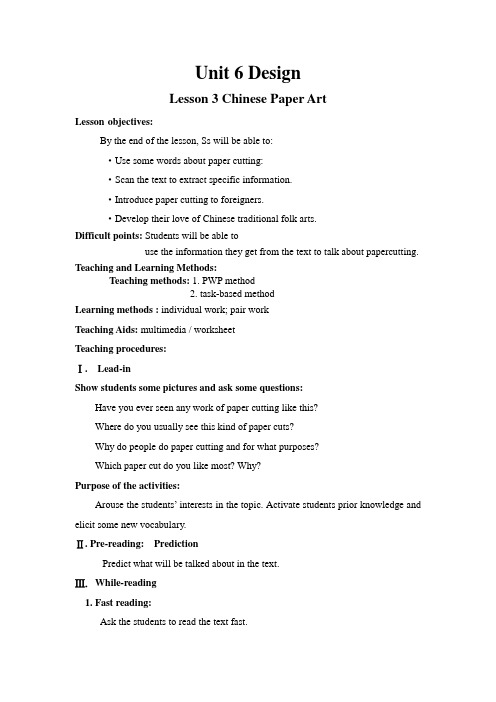
Unit 6 DesignLesson 3 Chinese Paper ArtLesson objectives:By the end of the lesson, Ss will be able to:·Use some words about paper cutting:·Scan the text to extract specific information.·Introduce paper cutting to foreigners.·Develop their love of Chinese traditional folk arts.Difficult points: Students will be able touse the information they get from the text to talk about papercutting. Teaching and Learning Methods:Teaching methods: 1. PWP method2. task-based methodLearning methods : individual work; pair workTeaching Aids: multimedia / worksheetTeaching procedures:Ⅰ. Lead-inShow students some pictures and ask some questions:Have you ever seen any work of paper cutting like this?Where do you usually see this kind of paper cuts?Why do people do paper cutting and for what purposes?Which paper cut do you like most? Why?Purpose of the activities:Arouse the students’ interests in the topic. Activate students prior knowledge and elicit some new vocabulary.Ⅱ. Pre-reading: PredictionPredict what will be talked about in the text.Ⅲ. While-reading1. Fast reading:Ask the students to read the text fast.Check the students’ prediction.Ask the questions about the text:When were paper cuts of animals found in China?How many types of paper cuts do people like to make today?2. Careful readingTask 1: Ask the students to read the text carefully and check the answers.1. What are the three types of paper cuts?2. How do we know that there is a long tradition of paper-cutting in China?3. Which Chinese character often appears in the wedding paper cuts?4. How is paper-cutting related to fashion?5. Why is the writer going to see Mr. Chen again.Task 2 : Reading for detailsAsk the students to get Chen’s information.Task 3 :Details about paper cuttingAsk the students to complete the chart about the paper cutting.Ⅳ. Post-reading:Get the students to do an interview according to what they have learnt.Ⅴ. Homework:Get the students to write a letter to one of the students’foreign friends introducing Chinese paper-cutting. (100 words)。
北师大版英语必修二Unit6Lesson3ChinesePaperArt学案设计

北师⼤版英语必修⼆Unit6Lesson3ChinesePaperArt学案设计Unit6 Design-Lesson3 Chinese Paper Art⼀、学习⽬标1. To practise scanning the text to extract(获取)specific information.2. To practise using vocabulary related to paper cutting.⼆、重难点分析1. To practise scanning the text to extract(获取)specific information.2. To practise using vocabulary related to paper cutting.三、学习过程Step 1: 通读课⽂,理解⼤意,并完成下列问题。
1. How do we know that there is a long tradition of paper-cutting in China?2. Who will make the paper-cutting as offerings on special days?3. Which example did Chen give me to show that paper-cutting was an important part of everyday life in ancient China?(提⽰:1. We know that because paper cuts of animals have been found in tombs which date back to the time of the Northern and Southern Dynasty.2.People to whom the dead person was related.= People whom the dead were related to. 3.A young farmer who wanted a wife would look at a young woman’s paper-cutting skills before marrying her.)Step 2: 核⼼词汇学习1. purpose n. ⽬的,意图He returned to his homeland with the purpose of serving his own people.他返回祖国,意在为祖国⼈民服务。
北师大版高中英语必修2 Unit 6《Design》(Lesson 1)教案3
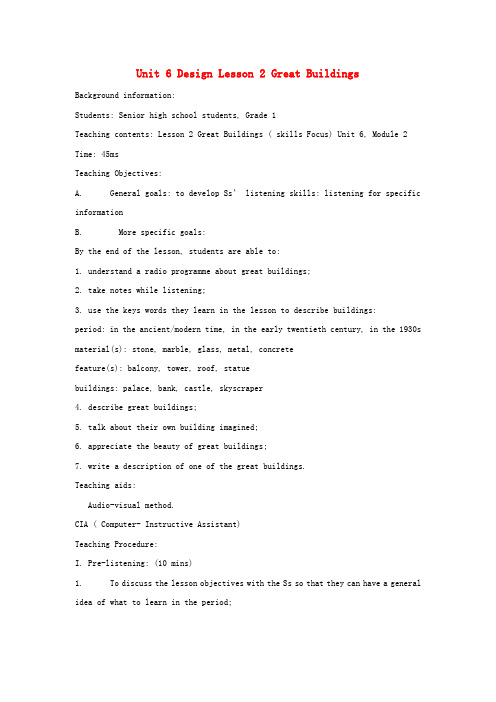
Unit 6 Design Lesson 2 Great BuildingsBackground information:Students: Senior high school students, Grade 1Teaching contents: Lesson 2 Great Buildings ( skills Focus) Unit 6, Module 2 Time: 45msTeaching Objectives:A. General goals: to develop Ss’ listening skills: listening for specific informationB. More specific goals:By the end of the lesson, students are able to:1. understand a radio programme about great buildings;2. take notes while listening;3. use the keys words they learn in the lesson to describe buildings:period: in the ancient/modern time, in the early twentieth century, in the 1930s material(s): stone, marble, glass, metal, concretefeature(s): balcony, tower, roof, statuebuildings: palace, bank, castle, skyscraper4. describe great buildings;5. talk about their own building imagined;6. appreciate the beauty of great buildings;7. write a description of one of the great buildings.Teaching aids:Audio-visual method.CIA ( Computer- Instructive Assistant)Teaching Procedure:I. Pre-listening: (10 mins)1. To discuss the lesson objectives with the Ss so that they can have a general idea of what to learn in the period;2. To motivate students to listen by taking a glimpse of some of the great buildings in the world;3. To learn Key Words by taking Petronas Towers in Kuala Lumper as an example.A) When was it built? What is it built of?It’s a modern building built in (1998) the late twentieth century. It’s made of glass, steel and concrete.What do people use to make such great buildings? (show pictures: metal, glass, concrete ,wood, bamboo, stone, etc.)B) What kind of building is it?It’s a skyscraper or a commercial office tower.T: Every building has its purpose. Look at the following buildings, guess what kind of building each one is. (Show pictures)(Picture 1) This is a a very tall modern city building ( a skyscraper) (Picture 2)This a building where people can read or borrow books. ( a library) (Picture.3) This is a place where people can put their money or take it out. (A bank) (Picture 4) This is a building with thick walls ,towers,. ( a castle)(Picture 5) This is a place where King and Queen live ( a palace)(Picture6) This is a building with a lot of rooms which people pay to live in. ( a hotel))4. FeaturesTake a closer look at the building, which part of it attracts you most? (A sky bridge, glass wall and roof)Layout on the blackboard:It was built in…It is/was made of …It’s a /one of the ….It has…/ There is … / It looks (like)… / It is the…(Goal for this step: Let the students watch, listen and understand keys words about buildings.)II. While-listening (20 mins)1. Listen to the radio programme for the first time, match the buildings in the photos with the names.2. Listen to the first two sections and choose the right answersSection A : Description of the Palace of the Doges1.What kind of building does the man mention?A. palaceB. bankC. skyscraperD. castle2.In which period was the building built?A. modernB. ancientC. 1930sD. early twentieth century3.What kind of material(s) was the building made of?A. concrete, metal and glassB. stoneC. not mentionedD. marble4.What features does the building have?A. balcony and statuesB. tower and thick wallsC. metal roofD. fantastic decorations on the roofSection B : Description of the Post Office Saving Bank1. What kind of building does the man mention?A. palaceB. bankC. skyscraperD. castle2. In which period was the building built?A. modernB. ancientC. 1930sD. early twentieth century3. The most beautiful part of the building is______.A. the wallB. the roofC. the balconyD. the statue4. The fantastic decorations represent the following except_______.A. angelsB. wavesC. fishD. flowers3. Listen to section 3 and fill in the formDescription of the Eilean Donan Castle4. Read through and try to fill in the missing words in the description. Then listen to this section and check the answers.Description of the Chrysler BuildingThe Chrysler Building in _____ ______is not the skyscraper there, but it is one of the most________. This __________was made of new : metal, ________and glass. It was built in the _________ and hasa beautiful metal .5. Listen to the radio programme again as a whole and take notes (exercise 3) with the key information.III Post-listening: (15 mins)1. Choose one of the buildings to describe, using the tips given (5 mins): ( provide 3 buildings for Ss to choose from, including one from the listening material) Useful language:It is/was located… / It is one of the… / it was built… / It has………Name: Petronas TowersLocation: Kuala Lumper, MalaysiaDate : 1998Building Type: skyscraper / commercial office towerFeature: sky bridge2. Group work: If you were an architect, … (10 mins)What kind of building would you like to build? (Hotel? Skyscraper? …)Where would it be built? ( On the loch? in the forest? under the sea? on the moon?….)What materials w ould you use? ( concrete? plastic? paper? …)What would be so special about it? ( It would look like…)Share your idea about the building, even a crazy one!Optional activities and homework:Reflection:。
北师大版 高中英语 必修模块2 Unit 6 Design Chinese Paper Art 第三
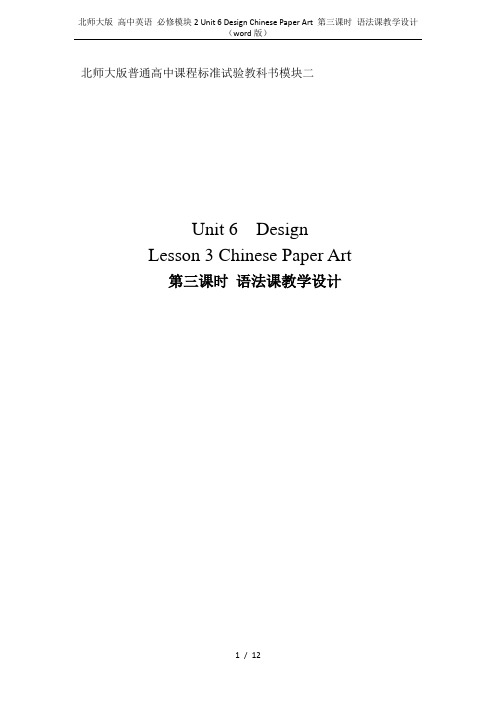
北师大版普通高中课程标准试验教科书模块二Unit 6 DesignLesson 3 Chinese Paper Art第三课时语法课教学设计一、教学分析(一)教学内容分析本单元的主题是“设计”,本课是模块2第6单元的第三课。
本课是一则采访介绍,内容是介绍中国的剪纸艺术的历史和三种形式,文章语言句式复杂,多是限制性定语从句构成的复合句。
本节课定位是本课内容的第三课时,即语法课——定语从句。
本课对定语从句这一语法的目标要求是能够识别定语从句,掌握关系代词who、whom、whose、which和that的基本用法,并且能够运用定语从句来对一个事物进行描述和定义。
(二)学情分析定语从句是初中三大从句中最后一个出现的一个语法内容。
初中英语教学大纲中要求初中生理解以及掌握关系代词that、who、whose、whom、which以及关系副词when、why、where引导的定语从句,类型仅限于限制性定语从句。
定语从句在平时的练习里面以及中招题里经常出现。
因此,对于高一上学期的学生来说,他们大多都能识别和理解一些简单的定语从句,但是大部分学生对定语从句的理解比较肤浅,不够全面深刻。
在做题时也常常出现一些典型错误。
另外,高一上学期的学生普遍还意识不到定语从句对于优化语言表达的优势作用,也缺乏主动根据语境需要使用定语从句的意识和能力,因为他们很少能够在语言运用中,比如作文中恰当并正确的运用定语从句来优化句子结构。
在学习能力上,高一学生已具备一定的分析和解决问题的能力,也有一定的团队合作意识,所以有通过独立和合作学习来完成一定的课堂任务的可能。
(三)教学目标基于以上分析,对于高一上学期模块二第六单元第3课包含定语从句这一语法教学任务的第三个课时,通过整合教材,授课教师把这节课的教学目标定位在以下方面:1.使学生复习定语从句基本关系代词的用法,并加深对这些基本规则的理解。
2.全面系统的构建学生对定语从句这一语法现象规则的基本知识体系,形成思维图式。
- 1、下载文档前请自行甄别文档内容的完整性,平台不提供额外的编辑、内容补充、找答案等附加服务。
- 2、"仅部分预览"的文档,不可在线预览部分如存在完整性等问题,可反馈申请退款(可完整预览的文档不适用该条件!)。
- 3、如文档侵犯您的权益,请联系客服反馈,我们会尽快为您处理(人工客服工作时间:9:00-18:30)。
《3 Chinese Paper Art》教学指导Objectives■To practise scanning the text to extract specific information.■To practise intensive reading skills.■To practise using relative clauses.■To practise giving definitions of words with the help of relative pronouns.■To practise using vocabulary related to paper cutting.Resources usedGrammar Summary 6, magazine pictures of Chinese paper cutting.Possible problems■ Students may confuse the use of who, whom, that and which or may have doubts about wh en to omit the relative pronoun.■ Students may also get confused about relative clauses introduced by whose: why it can refer not only to persons but also to objects; how to use it.BackgroundChinese paper-cuttings: Paper-cutting is one of China’s mo st popular forms of visual art. Paper and scissors are the usual materials utilized, but sometimes an engraving knife is also used. Paper-cutting has been a traditional art form for hundreds of years. It can be traced back to the 6th century; but only became apparent a few centuries after. Paper cuts are mainly used as decorations for religious and ornamental purposes.Routes through the material■ If you are short of time, set some of the exercises for homework and omit Exercise 11.■ If you have time, do the Option activities.■ If you have two periods for the lesson, a suitable natural break is after Exercise 5Language Power: pages 80-81.Mini-Grammar: 5.ReadingBefore you startExercise 1■ Students look at all the paper cuts and give the ir opinions on which they like the most.■ Encourage students to give reasons for their choices.Exercise 2■ Elicit from students on what occasions the Chinese use paper cuts. Encourage them to say asmuch as possible.Exercise 3Key WordsAnimals: phoenix, dragon, rooster, batColours: red, (dark) green, black, (light) blue, purple, yellow■ Check students’ knowledge of animals and colours. Encourage them to say more.■ Students read the example first so that they have a model to follow.■ Stu dents work in pairs and describe each paper cut, using as many Key Words as possible. If you wish, have each pair describe two of the paper cuts.■ Students then read their descriptions to the class.Read to learnExercise 4■ Students work individua lly, scanning the text for information about when and why paper cuts are used.■ Students look through the questions first and guess the possible answers. Then read the text carefully to find the answers to the questions.■ Students ask and answer the qu estions in pairs.Answers1 Three. Paper cuts for decorations, for religious purposes and for design patters.2 We know that because paper cuts of animals have been found in tombs dating back to the time of the Northern and Southern Dynasty.3 The Chinese character of double happiness often appears in wedding paper cuts.4 By using paper-cutting like a pattern on clothing or on a jewellery box.5 To learn paper cutting from him.■ Encourage students to add any other information that they know about p aper-cutting. Write the new facts on the board. Students discuss whether the new information can go into the existing paragraphs or whether new paragraphs are needed.Exercise 5■ In groups, students work out the meaning each paper cut has and discuss it.■ Each group reports their results to the class and gives reasons.Have a class discussion if necessary.GrammarRELATIVE CLAUSES (I)Exercise 6■ Write one sentence with a relative pronoun from the text on the blackboard. For example: Chen Zijiang is a paper-cutting expert whom I interviewed ...■ Encourage students to work in pairs and scan the text for other examples of relative pronouns. ■ In pairs, students work out which relative pronoun can refer to people or things. ( Better leave'whose' to learn later)■ As you check their answers, have them read out the sentences containing the particular relative pronouns.■ Write the sentence 'A present for parents whose child was born recently, for example, might show …' on the blackboard. Have students discuss what 'whose' refers to.■ Provide more sentences for students to fill in the proper relative pronouns.Exercise 7■ Students look at the sentences to see when we can omit who, that, which. Direct them to the first two examples and have students discuss when the pronouns can be omitted.■ Check the answers by having students read out the sentences with and without the pronouns.■ Refer students to Grammar Summary 6 for further study.Exercise 8■ Students go back to the text and fin d more examples of relative clauses. They may work in pairs and compare their findings.Exercise 9■ Read the instructions with the class. Advise students to follow the three steps in the order given for each sentence.■ Students can compare their answ ers in pairs before checking them as a class.Answers1 I loved the meal (that) we had last night.2 The opera (that) we saw last night was terribly boring.3 I think the architect who designed the new building is very creative.4 Have you bought the CD (which) I told you about?5 He was a painter whose pictures were not well-known in his lifetime.Exercise 10■ Students work individually to fill in the gaps.■ Check students’ answers by having them read the sentences aloud.Answers1 which/that2 who3 /4 whose5 who6 whoExercise 11■ Read the example with the class and elicit suggestions for the second sentences, e.g. I enjoy watching films (I have seen before/ animals appear in).■ Students complete the other sentences working individuall y, then read their sentences to their partners.■ Some of the students can read their sentences to the class.Language in UseExercise 12■ Students work in groups discussing ways of finishing the questions. Encourage them to addmore of these questions if they like.■ Then students work individually, writing their own questions. ■ In pairs, students take turns to interview their partner and write down the answers.■ If there is time, extend this so that students interview four or five other student s in the class.■ Students then report any interesting or surprising results back to the whole class.OptionsPractice for vocabularyFill in the blanks with the following words.date back, be used for/ as/ to do, decorate, decoration, double,religious, be related to, suggest1. The rise in crime is reported to ________ an increase in unemployment.2. They ________ animals ________ scientific experiments.3. I _______ talking to a lawyer before you do anything.4. The children always enjoy _______ the Christmas tree.5. The church, which _____ to the ninth-century, is being rebuilt.6. They didn’t attend the meeting because of _______ reasons.7. Last year she suffered from the ____ blow of losing her father and discovering that she had cancer.8. Have you put up your Christmas _______ yet?Answers1 be related to2 are using...for3 suggest4 decorating5 dates back6 religious。
